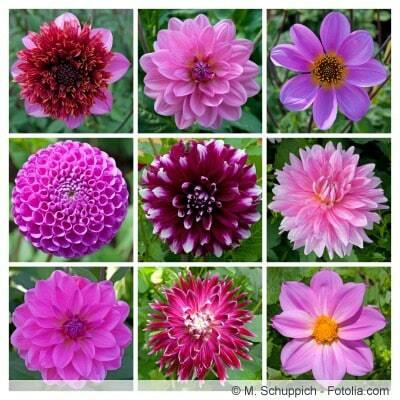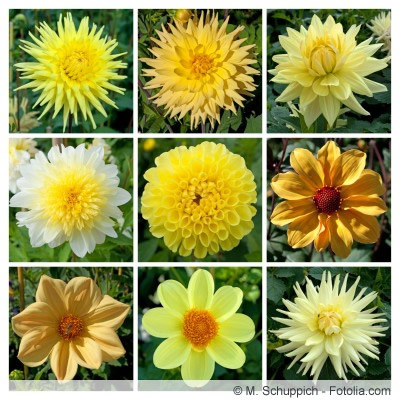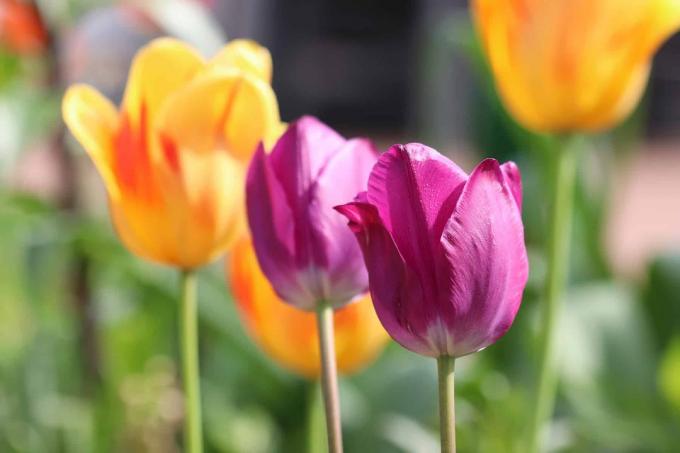

Table of contents
- systematics
- risk of confusion
- hybrids
- Colors
- Double Lilies
- tooltips
- propagation
- distribution
- Conclusion
Botanically, lilies belong to the monocot family Liliaceae. Many of the lily species of this genus are also hardy in our latitudes. The above-ground parts move in in autumn and the plants for the next year then form in their bulbs. There is now a huge range of different hybrids of various types of lilies on the market. A closer look at the most beautiful variants with all their wealth of colors and growth forms is definitely worthwhile.
systematics
The approximately one hundred species of lilies have been crossed with each other for decades to obtain particularly beautiful and robust hybrids. Some species crossed together produce hybrids. These are plants that have different characteristics from their parents and are capable of reproduction. Other attempts to cross different types of lilies will not produce seed.
Harold Frederick Comber introduced a new classification of Lilium in 1949. He divided the species, including their hybrids, into seven sections (later classification: divisions):
- American section
- Asian section
- Candida section
- longiflorum section
- Martagon section
- Oriental section
- trumpet section
- (other and wild forms)
The most popular hybrids native to Germany come from the lily species:
- Orange lily (Lilium bulbiferum)
- Madonna Lily (Lilium candidum)
- Tiger Lily (Lilium lancifolium)
- Turk's cap lily (Lilium martagon, Lilium cernuum)
- Trumpet Lilies (Lilium aurealianum)
- Japanese mountain lily (Lilium auratum)
risk of confusion

Both the iris and the African lily are not members of the Liliacae family, although they do have the term "lily" in their name. They belong to the iris family (Iridacecae) and amaryllis family (Amaryllidaceae). Both families come from the order Asparagales and not Liliales.
hybrids
Lilium auratum
This mountain lily from Japan usually bears eight or more fragrant, large, beautiful flowers on one stem. Hardy onion with light coverage. She likes it cool and wet.
- 'Cupido': It has many red flowers
- 'Marseille': white flowers with a soft pink tinge
- 'Miss Lucy': light pink, double flowers without stamens
- 'Sphinx': deep red flower without stamens
Lilium Aurelian
The trumpet lilies usually have a strong scent and prefer a location in the light shade.
- 'Royal Gold': golden yellow flowers up to 1.50 m high
- 'Pink Perfection': pink flowers with a white central stripe, height up to 1.50 m
- Longiorum 'Elegant Lady': flowers pink, has a strong scent; suitable as a cut flower.
- 'White American': white flowering trumpet lily; is particularly suitable as a pot flower; flowers up to nine centimeters in size; pleasant smell; 60 cm height.
- 'White Elegance': pure white flowers; Trumpet lily with large flowers;
Lilium bulbiferum
Most tiger lily hybrids are bright orange with brown spots. The umbels, up to a meter high, can carry up to twenty flowers. They like it rather sunny with slightly calcareous soil.
Lilium candidum
In its natural form, the Madonna lily is pure white, grows up to one meter high and forms up to eight fragrant flowers. It is hardy and should be covered with brushwood in harsh climates.

Lilium cernuum
The Turk's cap lily flowers in shades of purple, pink and light purple. The flowers are delicately scented and grow up to seven centimeters in size.
- Martagon 'Album': pure white flowers; grows low; is suitable for rock gardens
- Lilium hansonii: Turk's cap lily; forms golden-yellow flowers with dark speckles; quickly forms large clumps
- Lilium henryi: giant martagon lily; very vigorous and robust; orange-yellow flowers; unscented; particularly undemanding and durable
Colors
Lilies of all types and shapes are effective because of their strong colors. Here is a small list of lily species and
Hybrids according to their colors:
White
- Lilium Aurelian 'White American'
white trumpet flowers; fragrant;
- Lilium Aurelian 'White Elegance'
trumpet lily; flower large, pure white;
- Lilium martagon 'album'
pure white; many, small, nodding flowers
- Lilium regale 'Siberia'
many white flowers
- Lilium regale 'Starling Star'
creamy white, speckled flowers
- Lilium auratum 'Mister Ed'
pure white; strongly fragrant;
- Lilium candidum, pure white wild form; strongly scented

Yellow
- Lilium hansonii, Turk's cap lily; golden flower
- Lilium Leichtlinii, bright yellow flowers with speckles
- Lilium monadelphum
- caucasus lily; yellow flowering
- Lilium pyrenaicum
- flower yellow; black spotted, Lilium speciosum 'Citronella'
- flowers lemon yellow, Lilium auratum 'Royal Gold'
- golden yellow flowers, Littonia modesta
- climbing lily; yellow flowers
- Orange Brown Lilium 'Apeldoorn'
- orange-red flowers, Lilium Barcelona,
- orange-red flowers; radiating yellow from the inside, Lilium tigrinum 'splendens'
- flowers orange; mottled brown, Lilium bulbiferum 'Orange Triumph'
- flowers orange to yellow; in umbels, Lilium bulbiferum (umbellatum)
- natural form; bright orange flowers, Lilium pardalinum
- glossy orange flowers; spotted rusty brown; many flowers; panicles
Red
- Lilium auratum 'Imperial Crimson'
- deep crimson flowers, Lilium auratum 'Nobility'
- ruby red flowers, Lilium auratum 'Cupido'
- red flowers, Lilium auratum 'Sphinx'
- blooms deep red; double flowers, Lilium speciosum var. rubrum
- crimson flamed blossoms; mottled deep red, Lilium tenuifoliu
- coral lily; flower coral red; Lilium tigrinu
- tiger lily; orange-red flower; black spotted; nodding;
Pink, purple
- Lilium Aurelian 'Pink Perfection', pink with white central stripe, Lilium auratum 'Trance'
- light pink flowers; strongly fragrant; large flowers, Lilium auratum 'Journeys End'
- pink flowers; wide white border, Lilium longiflorum 'Elegant Lady'
- pink flowers; strongly scented, Lilium cernuum
- natural form; Flowers lilac-pink to light violet; delicately scented, Lilium auratum 'Marseille'
- white flowers with a soft pink hue, Lilium auratum 'Miss Lucy'
- Flowers light pink; double flowers
Double Lilies
Double lilies, such as Lilium auratum 'Miss Lucy', 'Fata Morgana' and 'Red Twin', not only impress with their special appearance. They are also interesting for people who are allergic to pollen. The otherwise very strong stamens are transformed into petals in these varieties, so they are pollen-free. They are therefore also well suited for the vase.
tooltips
onion, root
Even if all types of lilies have a bulb, they do not belong to the bulb family. The latter belong to the order of the Asparagales, the Amaryllis family. Lilies belong to the order Liliales.

All species of the genus Lilium have this so-called bulbus with overlapping scales. Some of the roots have the amazing ability to pull the bulb deeper into the soil depending on water and nutrient needs.
blossom
Roughly speaking, they can be divided into three different flower shapes:
- trumpet-shaped (trumpet lily, royal lily)
- cupped (Madonna lily, fire lily)
- rolled up (Turk's cap lily, tiger lily)
The flowers are usually composed of six large petals. The colors and patterns are usually very striking. There are types of lilies that are strongly scented or not scented at all.
Tip:
For the vase, the lilies are cut off to about two-thirds of the stem length just before they bloom. In late autumn, cut off the dried stems close to the ground.
propagation
Lilies reproduce both by their seeds (cross-pollination) or vegetatively by:
- spring onions
- rhizome
- foothills
distribution
Lilies are at home throughout the northern hemisphere. Most lily species come from Asia, where new species are still being discovered from time to time. Lilies like it in partial shade, moist, with good drainage and rather cool. Many varieties are hardy.
Conclusion
The genus Lilium has a large selection in the most beautiful colors for the garden. Lilies can easily be in the same location for several years. The onions of the more sensitive varieties are covered with brushwood in winter. If the willingness to bloom decreases over the years, the bulbs are simply put in a different place. They also cut a fine figure as cut flowers and in tubs. Luckily, most lilies, despite looking so classy and showy, are surprisingly hardy and easy to care for.
 garden editorial
garden editorial I write about everything that interests me in my garden.
Learn more about flower bulbs

Tulips do not bloom and only put out leaves: what to do?
Tulips are among the most popular spring bloomers. They are therefore extremely common in domestic gardens. However, various causes can lead to the onion plants only developing leaves and no flowers. You can find out what to do in this case here.

Madonna lily, Lilium candidum: 9 care tips
Due to its growth height of more than one meter and the imposing white funnel-shaped flowers, the Madonna lily is one of the most impressive native bulbous plants. What to look out for when caring for this impressive flower is summarized in 9 clear care tips.

Daylilies, Hemerocallis: care from A – Z
Daylilies (Hemerocallis) are among the loveliest and most rewarding flowering perennials. Even if each individual blossom lasts only one day, countless new blossoms form again and again and decorate the garden for weeks. In addition, they are available in almost every color imaginable.

Freesia, Freesia: care tips from A - Z
Freesias are popular summer plants because they are colorful and have a pleasant, delicate scent. The irises, originally from Africa, are not difficult to care for, but do not tolerate frost. You can easily propagate the freesias yourself using the bulbs.

Milk Star, Ornithogalum: care from A to Z
The Orange Milk Star (Ornithogalum dubium) is a popular ornamental plant from the Cape Province. Because of its decorative flowers, it is often used as a cut flower in flower arrangements. The ornamental plants are undemanding, but should be cared for with caution due to their toxicity.

Checkered flower: care from A to Z | Instructions
The checkered flower (Fritillaria meleagris) attracts everyone's attention with its bell-shaped flowers. The reason for this is their striking pattern, which is strongly reminiscent of a chessboard. This striking check pattern shows the bulb flower in different shades.
